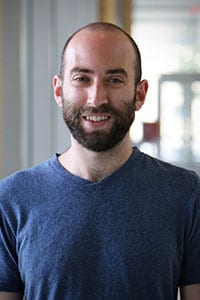Tumors are complicated. Scientists can examine individual tumor cells and find varying patterns of gene expression. Sample those same locations again at a later time, and new patterns may emerge. Multiply these experiments by dozens of locations, thousands of genes, and several time points, and now there is a huge dataset that may seem impossible to analyze.

That’s where Matt Bernstein comes in.
During his time as a Morgridge Postdoctoral Fellow, Bernstein focused on building computational tools that researchers use to make sense of such complex data. His most recent contribution, SpatialCorr, was built to look at patterns in large datasets resulting from examination of tumors or other diseased tissue. (SpatialCorr is described in a preprint awaiting review and publication.)
Before SpatialCorr, researchers already had the ability to obtain gene expression levels in cells retrieved from specific locations in a tissue, and they could identify single genes with activation levels that vary from location to location.
Genes, however, rarely act alone. Instead, they are usually part of a coordinated set of genes whose activation levels correlate with each other. The SpatialCorr algorithms let researchers examine whether entire sets of genes change in a related way depending on their location within the tissue sample.
SpatialCorr could be valuable in the study of cancer’s interactions with the immune system, of diseases like ALS, and of several other biological systems.
Prior to building SpatialCorr, Bernstein contributed several other computational tools to the research community, and he believes it helps science move forward.
While at Morgridge, he published CHARTS, a platform to help researchers explore tumor gene expression data in NCBI’s public database. During graduate school, he developed CellO, which analyzes large gene expression datasets to characterize and identify cell types.
“It’s really useful for researchers to make datasets publicly available, and combining that data in new ways can create new insights,” says Bernstein.
Bernstein’s fellowship advisors, Morgridge Investigator Ron Stewart and Biostatistics and Medical Informatics Professor Christina Kendziorski, credit him for acting as a bridge between their respective specialties of bioinformatics and statistics.
“Matt served as the bridge between our biostatistics, bioinformatics, and oncology groups,” says Kendziorski. “His formal computational training coupled with a desire to make high-impact contributions to cancer research made him the ideal candidate for this position.”
“One of the great things about being a Morgridge Fellow is the freedom it provides to design your own project. It really lets you live up to the ‘fearless science’ motto of the institute.”
Matt Bernstein
Stewart also notes Bernstein’s impact on another project: a collaboration between the Morgridge Institute, UW – Madison, and Albany Medical Center in New York to quickly analyze and share large, multi-omic data sets describing the molecular underpinnings of COVID-19.
“Matt’s ability to join that team was crucial,” explains Stewart. “He was able to make strong contributions to a high-impact, fast-moving project under a lot of pressure.”
Today, Bernstein is shifting from creation of new tools and is now spending more time using them.
After finishing his Morgridge Postdoctoral Fellowship in March 2022, he joined the computational biology team at Immunitas Therapeutics, a Boston-area startup that uses data from human tumor and primary cells to identify new cancer therapies.
“It’s exciting to be in a role where I can analyze data sets, identify gaps, and then guide new experiments that augment existing information,” he says.
Bernstein also notes the adjustment that comes with transition to a more fast-paced setting of an industry role, saying that he appreciates being a peer in a group working toward a focused set of outcomes.
Reflecting on where he’s been and where he’s headed, Bernstein recalls that he’s always had role models that encouraged him to ask questions and express his curiosity. Curiosity drove his interest in computer science, excitement for machine learning, pursuit of a graduate degree, and movement into a research career.
And although he has chosen an industry career path, he appreciates the academic fellowship that gave him a chance to explore options.
“One of the great things about being a Morgridge Fellow is the freedom it provides to design your own project,” Bernstein says. “It really lets you live up to the ‘fearless science’ motto of the institute.”
